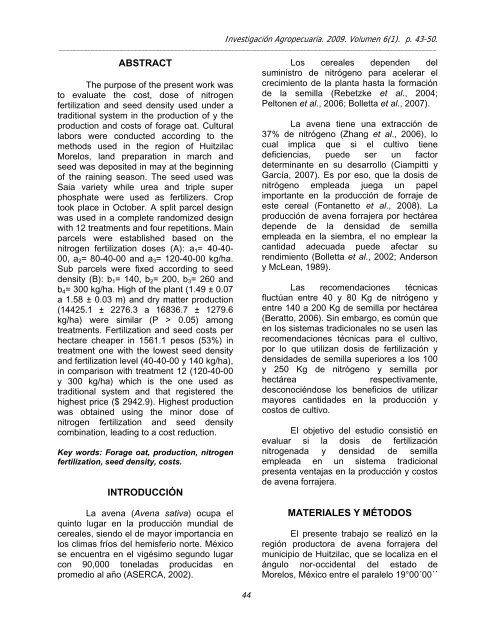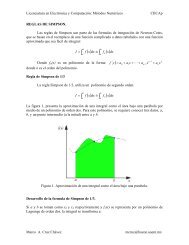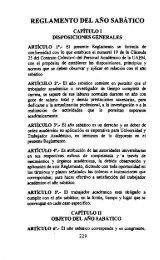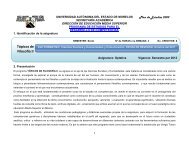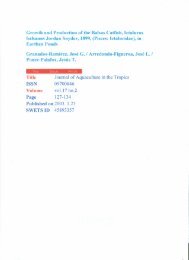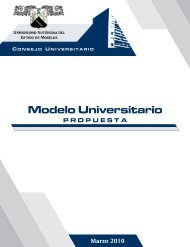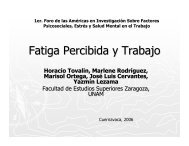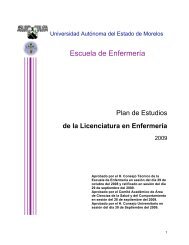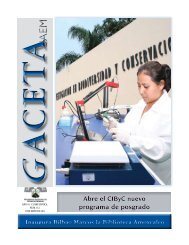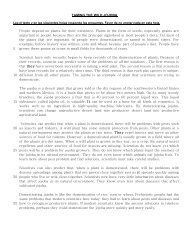Descargar - UAEM - Universidad Autónoma del Estado de Morelos
Descargar - UAEM - Universidad Autónoma del Estado de Morelos
Descargar - UAEM - Universidad Autónoma del Estado de Morelos
Create successful ePaper yourself
Turn your PDF publications into a flip-book with our unique Google optimized e-Paper software.
Investigación Agropecuaria. 2009. Volumen 6(1). p. 43-50.<br />
_________________________________________________________________________________________________________<br />
ABSTRACT<br />
The purpose of the present work was<br />
to evaluate the cost, dose of nitrogen<br />
fertilization and seed <strong>de</strong>nsity used un<strong>de</strong>r a<br />
traditional system in the production of y the<br />
production and costs of forage oat. Cultural<br />
labors were conducted according to the<br />
methods used in the region of Huitzilac<br />
<strong>Morelos</strong>, land preparation in march and<br />
seed was <strong>de</strong>posited in may at the beginning<br />
of the raining season. The seed used was<br />
Saia variety while urea and triple super<br />
phosphate were used as fertilizers. Crop<br />
took place in October. A split parcel <strong>de</strong>sign<br />
was used in a complete randomized <strong>de</strong>sign<br />
with 12 treatments and four repetitions. Main<br />
parcels were established based on the<br />
nitrogen fertilization doses (A): a1= 40-40-<br />
00, a2= 80-40-00 and a3= 120-40-00 kg/ha.<br />
Sub parcels were fixed according to seed<br />
<strong>de</strong>nsity (B): b1= 140, b2= 200, b3= 260 and<br />
b4= 300 kg/ha. High of the plant (1.49 ± 0.07<br />
a 1.58 ± 0.03 m) and dry matter production<br />
(14425.1 ± 2276.3 a 16836.7 ± 1279.6<br />
kg/ha) were similar (P > 0.05) among<br />
treatments. Fertilization and seed costs per<br />
hectare cheaper in 1561.1 pesos (53%) in<br />
treatment one with the lowest seed <strong>de</strong>nsity<br />
and fertilization level (40-40-00 y 140 kg/ha),<br />
in comparison with treatment 12 (120-40-00<br />
y 300 kg/ha) which is the one used as<br />
traditional system and that registered the<br />
highest price ($ 2942.9). Highest production<br />
was obtained using the minor dose of<br />
nitrogen fertilization and seed <strong>de</strong>nsity<br />
combination, leading to a cost reduction.<br />
Key words: Forage oat, production, nitrogen<br />
fertilization, seed <strong>de</strong>nsity, costs.<br />
INTRODUCCIÓN<br />
La avena (Avena sativa) ocupa el<br />
quinto lugar en la producción mundial <strong>de</strong><br />
cereales, siendo el <strong>de</strong> mayor importancia en<br />
los climas fríos <strong><strong>de</strong>l</strong> hemisferio norte. México<br />
se encuentra en el vigésimo segundo lugar<br />
con 90,000 toneladas producidas en<br />
promedio al año (ASERCA, 2002).<br />
44<br />
Los cereales <strong>de</strong>pen<strong>de</strong>n <strong><strong>de</strong>l</strong><br />
suministro <strong>de</strong> nitrógeno para acelerar el<br />
crecimiento <strong>de</strong> la planta hasta la formación<br />
<strong>de</strong> la semilla (Rebetzke et al., 2004;<br />
Peltonen et al., 2006; Bolletta et al., 2007).<br />
La avena tiene una extracción <strong>de</strong><br />
37% <strong>de</strong> nitrógeno (Zhang et al., 2006), lo<br />
cual implica que si el cultivo tiene<br />
<strong>de</strong>ficiencias, pue<strong>de</strong> ser un factor<br />
<strong>de</strong>terminante en su <strong>de</strong>sarrollo (Ciampitti y<br />
García, 2007). Es por eso, que la dosis <strong>de</strong><br />
nitrógeno empleada juega un papel<br />
importante en la producción <strong>de</strong> forraje <strong>de</strong><br />
este cereal (Fontanetto et al., 2008). La<br />
producción <strong>de</strong> avena forrajera por hectárea<br />
<strong>de</strong>pen<strong>de</strong> <strong>de</strong> la <strong>de</strong>nsidad <strong>de</strong> semilla<br />
empleada en la siembra, el no emplear la<br />
cantidad a<strong>de</strong>cuada pue<strong>de</strong> afectar su<br />
rendimiento (Bolletta et al., 2002; An<strong>de</strong>rson<br />
y McLean, 1989).<br />
Las recomendaciones técnicas<br />
fluctúan entre 40 y 80 Kg <strong>de</strong> nitrógeno y<br />
entre 140 a 200 Kg <strong>de</strong> semilla por hectárea<br />
(Beratto, 2006). Sin embargo, es común que<br />
en los sistemas tradicionales no se usen las<br />
recomendaciones técnicas para el cultivo,<br />
por lo que utilizan dosis <strong>de</strong> fertilización y<br />
<strong>de</strong>nsida<strong>de</strong>s <strong>de</strong> semilla superiores a los 100<br />
y 250 Kg <strong>de</strong> nitrógeno y semilla por<br />
hectárea respectivamente,<br />
<strong>de</strong>sconociéndose los beneficios <strong>de</strong> utilizar<br />
mayores cantida<strong>de</strong>s en la producción y<br />
costos <strong>de</strong> cultivo.<br />
El objetivo <strong><strong>de</strong>l</strong> estudio consistió en<br />
evaluar si la dosis <strong>de</strong> fertilización<br />
nitrogenada y <strong>de</strong>nsidad <strong>de</strong> semilla<br />
empleada en un sistema tradicional<br />
presenta ventajas en la producción y costos<br />
<strong>de</strong> avena forrajera.<br />
MATERIALES Y MÉTODOS<br />
El presente trabajo se realizó en la<br />
región productora <strong>de</strong> avena forrajera <strong><strong>de</strong>l</strong><br />
municipio <strong>de</strong> Huitzilac, que se localiza en el<br />
ángulo nor-occi<strong>de</strong>ntal <strong><strong>de</strong>l</strong> estado <strong>de</strong><br />
<strong>Morelos</strong>, México entre el paralelo 19°00´00´´


